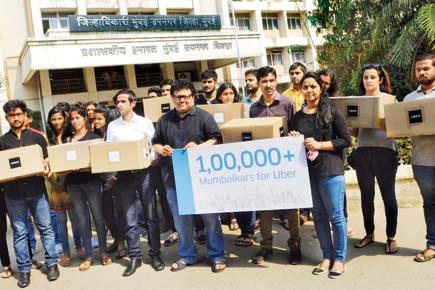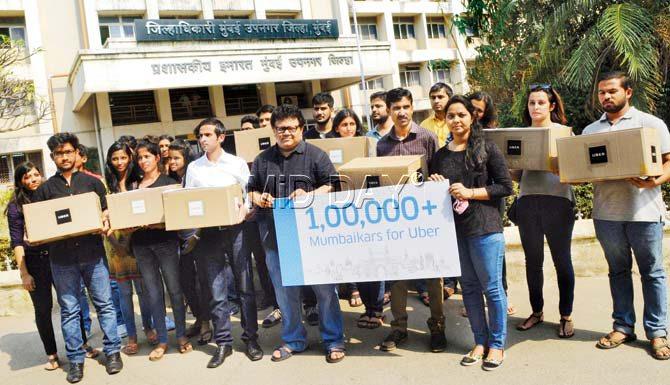To prevent monopoly of mobile cab aggregators, draft Maharashtra City Taxi Rules 2016 lays down stringent guidelines

General manager of Uber West Shailesh Sawlani handed over 1 lakh petitions from passengers to state transport commissioner Dr. Praveen Gedam in Bandra on Friday. Pic/Datta Kumbhar

General manager of Uber West Shailesh Sawlani handed over 1 lakh petitions from passengers to state transport commissioner Dr. Praveen Gedam in Bandra on Friday. Pic/Datta Kumbhar
ADVERTISEMENT
The state government wants to ensure that Mumbai doesn't become a China, as far as monopoly of mobile cab aggregators is concerned. Sources said that to prevent this, the draft Maharashtra City Taxi Rules 2016 lays down stringent guidelines. Mobile aggregators, however, are up in arms, claiming that the waiting period for cabs for people will go up from the present two to four minutes to 15-20. Today is the last day for giving suggestions and objections to the draft Rules.
Playing fair?
The state transport department will today send all the suggestions received on the draft Rules, which aim to create a level-playing field for all taxi services, such as the kaali-peelis, fleet cabs Meru and TabCab, and mobile aggregators Uber and Ola, to the Centre. If the government finds any suggestion relevant, the Rules will be amended accordingly.
“Under the current circumstances, there is a possibility that in the near future mobile aggregators will monopolise the market, affecting the business of other cab operators. We want to ensure that there is no mismatch as far as policies are concerned,” said a senior transport official.
The department also claimed that problems due to such monopoly have been seen in China, Singapore and even some European countries. And the taxi unions running the show for the black-and-yellow cabs are already crying over the dropping demand from people, they added.
The number game
Their numbers are constantly dropping and now stand at 36,000 taxis. And while 7,500 new permits have been allowed, their induction into the fleet is time-consuming. This is possibly why the Rules mention making badges, like those worn by black-and-yellow cab drivers, mandatory for all, as well as a payment of R25,000 for permit, which currently only the kaali-peeli drivers pay.
Fleet operators Meru and TabCabs too have been doing sluggish business and haven't increased their fleet over the past few years now — Meru has less than 2,500 vehicles, TabCab less than 2,300, while Easy Cabs barely have 500.
“We had planned to increase our fleet to 10,000, but drop in demand didn't let that happen. We have raised our queries, but overall, the draft Rules seem good as they have created a better situation for all operators,” said Siddharth Pahwa, president, All-India Radio Taxi Association.
Uber and Ola, on the other hand, shared minimum information about the number of their vehicles on roads and the number of their drivers who would be affected by the draft Rules. “It is against our policy to share numbers and statistics. But we welcome the Rules and will be giving our views to the transport department on Nov 5,” said Joy Bandekar, corporate president (new initiatives), Ola.
Who's ready to pay more?
Ola officials said the increase in costs for them — payment to get a permit and a cap on fares — will make the business unviable and ultimately lead to the passengers having to shell out more.
Uber said it has 75,000 drivers across the state and more than 90 per cent of them ply in Mumbai. “If 50 per cent of total vehicles have to compulsorily be made 1,400 CC (permit for which would cost R2.61 lakh), then it will affect the demand and result in increased fares. Only 6-7 per cent of the total passengers are ready to pay more than the existing fares,” said Shailesh Sawlani, general manager, Uber India. The company claimed that around 15 per cent of all the commercial vehicles plying as tourist cabs are over 1,400 CC.
36,000
Number of kaali-peelis in the city
75,000
No of Uber drivers across the state
 Subscribe today by clicking the link and stay updated with the latest news!" Click here!
Subscribe today by clicking the link and stay updated with the latest news!" Click here!






